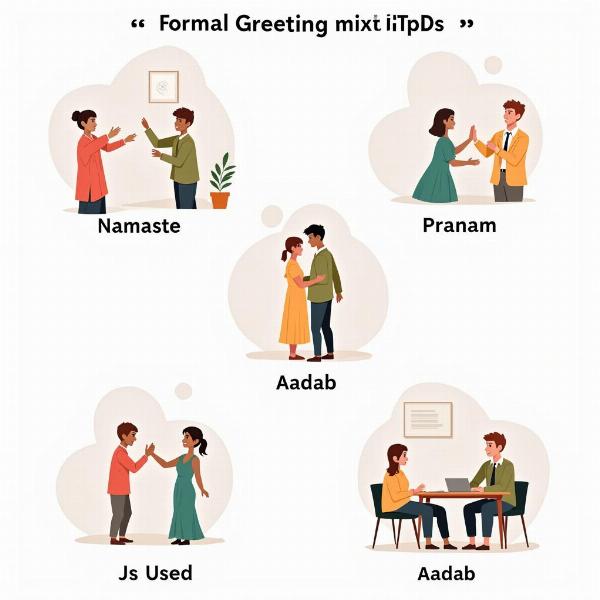Understanding how to greet someone respectfully in Hindi is crucial for navigating social and professional interactions in India. “Greetings sir meaning in Hindi” encompasses a range of formal and informal expressions, each carrying its own nuances and cultural significance. This guide will delve into various ways to say “greetings sir” in Hindi, exploring their contextual usage and providing practical examples to help you communicate effectively.
Formal Greetings in Hindi
Formal greetings are essential in professional settings, when addressing elders, or interacting with individuals you don’t know well. Here are some common formal ways to greet “sir” in Hindi:
- Namaste (नमस्ते): This is the most common and universally accepted respectful greeting in Hindi. It’s appropriate for all occasions and can be used with anyone, regardless of age or status. Namaste transcends religious boundaries and is a gesture of respect and acknowledgement.
- Pranam (प्रणाम): Similar to Namaste, Pranam is a highly respectful greeting often used for elders or those in positions of authority. It conveys deep respect and reverence.
- Aadab (आदाब): This greeting, borrowed from Urdu, is commonly used in North India, especially in formal settings. It’s a polite and respectful way to greet someone.
- Shubh Prabhat (शुभ प्रभात): Meaning “Good Morning,” this greeting is used specifically in the morning.
- Shubh Sandhya (शुभ संध्या): Meaning “Good Evening,” this is used from late afternoon onwards.
- Namaskar (नमस्कार): A more formal variation of Namaste, often used in official or ceremonial contexts.
 Formal Hindi Greetings
Formal Hindi Greetings
Informal Greetings in Hindi
Informal greetings are used with friends, family, and close acquaintances. These greetings often convey warmth and familiarity.
- Ram Ram (राम राम): Commonly used in North India, this is a casual and friendly greeting.
- Namaste Ji (नमस्ते जी): Adding “Ji” to Namaste adds a touch of informality while still maintaining respect. It’s a versatile greeting suitable for both formal and informal situations.
- Kya Haal Hai? (क्या हाल है?): Meaning “How are you?”, this is a common informal greeting used to inquire about someone’s well-being.
- Kaise Ho? (कैसे हो?): Another way to ask “How are you?”, used more commonly in informal settings.
Context Matters: Choosing the Right Greeting
Selecting the appropriate greeting is essential to ensure respectful and effective communication. Consider the following factors:
- Formality of the situation: Use formal greetings in professional or official settings and informal greetings with friends and family.
- Age and status: Use more respectful greetings like Pranam or Namaskar for elders or those in positions of authority.
- Regional variations: Be aware of regional variations in greetings. For example, Ram Ram is more common in North India.
- Time of day: Use Shubh Prabhat in the morning and Shubh Sandhya in the evening.
Addressing Someone as “Sir” in Hindi
While “Sir” doesn’t have a direct Hindi equivalent used as a greeting, the respect it conveys is incorporated through tone and the choice of greeting. Using formal greetings like Namaste, Pranam, or Aadab demonstrates respect and acknowledges the person’s status. You can also use honorifics like “Ji” (जी) after the person’s name to show respect.
Conclusion
Mastering Hindi greetings is a vital step in building strong relationships and navigating Indian culture. By understanding the nuances of formal and informal greetings, you can communicate effectively and show respect in any situation. Remember to choose the appropriate greeting based on the context and always err on the side of formality when in doubt. Understanding the meaning behind “greetings sir” in Hindi allows for a deeper appreciation of the cultural importance of respectful communication.
FAQ
- What is the most common way to greet someone in Hindi? Namaste is the most common and universally accepted greeting.
- How do I greet an elder in Hindi? Pranam or Namaskar are appropriate respectful greetings for elders.
- What is the Hindi greeting for “Good Morning”? Shubh Prabhat.
- What is the Hindi greeting for “Good Evening”? Shubh Sandhya.
- Is there a direct translation for “Sir” as a greeting in Hindi? While not a direct translation, respect is conveyed through the choice of greeting and tone.
- Can I use “Ji” with Namaste? Yes, Namaste Ji is a versatile greeting, suitable for both formal and informal settings.
- What are some informal greetings in Hindi? Ram Ram, Kya Haal Hai?, and Kaise Ho? are common informal greetings.
Meaning-Hindi.in is your trusted partner for professional Hindi translation services. We offer a wide range of specialized translation solutions, including business and commercial document translation, certified and legal document translation, technical and user manual translation, website and localization services, educational and academic document translation, express translation, and specialized industry translations. Contact us today for accurate and culturally sensitive Hindi translations. Email: [email protected], Phone: +91 11-4502-7584. Let Meaning-Hindi.in help you bridge the language gap!